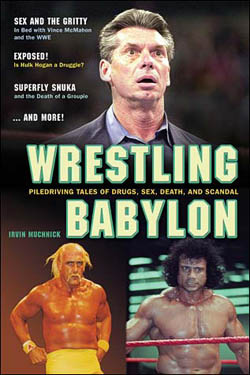The world of sports entertainment (a.k.a. professional wrestling), like an onion, has many layers. If you want to see and appreciate it at its most basic, one can simply take what they see on TV as the gospel truth. For those who want to dig a few layers deeper down to its stinky core, then a book such as Irvin Muchnick’s Wrestling Babylon is the way to go.

When I first began reading Wrestling Babylon: Piledriving Tales of Drugs, Sex, Death, and Scandal, published by ECW Press, I figured the only type of person who would be interesting in reading such a book would be a fan of Muchnick. But the more I read, the more I came to realize the opposite to be true.
Yeah, sure, Muchnick fans I’m sure will be happy to reacquaint themselves with stories from the past, but wrestling fans whom are not familiar with Muchnick’s works will walk away with so much more.
Wrestling Babylon is a compilation of key Muchnick stories, which have been printed in a variety of publications, both wrestling and mainstream. And the impact should not be understated.
However, the real strength of Muchnick’s book are the “Hey, I didn’t know that” moments one gets from chapter to chapter. The level of detail and insight provided in each section shed a new light on significant events in wrestling’s past, particularly as they relate to the WWF/E and Vince McMahon.
The book kicks off with a historical piece Muchnick penned on his uncle, Sam Muchnick, in many ways comparing him to Vinny Mac, then and now. This chapter inadvertently provides the reader with some context for a good chunk of the chapters that follow.
Without reviewing each chapter individually, there are a few that certainly warrant attention — the first being the section on the Von Erichs.This chapter is significant for two reasons. First, it provides incredible insights into this wrestling family, and really details the rise and fall of the Von Erich business. However, this chapter offers a good view into what was, and in many cases still is, wrong with the industry and how it can ruin the lives of those involved.
Next is the chapter entitled “Pimping Iron,” which focuses on McMahon’s business journey into the world of weightlifting — another of his attempts to diversify Titan Sports. This chapter showcases the more ruthless business side of McMahon, exposing characteristics of him that everyday viewers see on TV but never actually believe exist. The reader gets a much clearer view of how McMahon competes with those in whichever industry he’s trying to control, while also displaying how those who work for him behave and are treated.
Throughout the book Muchnick writes about steroids and their effect on the industry, from nearly bringing down the WWF/E (McMahon in particular), to the physical and mental effects on those using them. “Hogan’s Zeroes” is one chapter that really gets into the nuts and bolts of these drugs, bringing in a more human side to their deadly results rather than the industry or medical points of view. This chapter also provides a damning look at the industry’s biggest icon — Hulk Hogan.
Muchnick packs a lot of information into his 155-page book, and he is able to do so with his clear and “get to the point” writing style. In some areas his approach is very business-like, which adds credibility and a real sense of objectivity. However, it can also make for some pretty heavy reading in some places.
In addition to the business-like tone, what I found surprising is Muchnick’s use of, well, complicated words. What muscles are to Dave Batista, words are to this author, and he is not afraid to flex his muscles every now and then. While I can appreciate the proper use and value certain words bring, they can become a distraction. And considering the target audience of such a book — the every day, common wrestling fan — I do question this approach. Best have a dictionary nearby.The only other criticism I have of Muchnick’s Wrestling Babylon is the repetition of certain stories throughout.
Three examples come immediately to mind: The steroid scandal that involved the WWF/E, many of its stars, and Dr. George Zahorian; the story behind changing the venue for WrestleMania VII due to a storyline exploiting the Gulf War; and the sexual harassment case between former WWF employee Tom Cole and the WWF (Pat Patterson, Terry Garvin and others).
The significance of each story is obvious to the book and industry, but all three come up time and time again in various sections of the book. Again, this tends to become more of a distraction to the reader, especially when much of the information is no longer new and becomes redundant. This is an inherent flaw in reprinting old articles.
All in all, Wrestling Babylon is a good read, both for fans of Muchnick but more so for those who are not familiar with his work. What readers will walk away with is a much better understanding of the wrestling industry from behind the curtain, and an enhanced appreciation of those whose lives it has affected.












